- grandMA2 User Manual
- Introduction
- About this manual
- System requirements grandMA2 onPC
- Installation of grandMA2 onPC
- Help from MA technical support
- Safety Information
- Symbols used
- Intended use
- Dangers caused by electric current
- General safety instructions
- Device Overview
- grandMA2 console
- grandMA2 replay unit (RPU)
- grandMA2 fader wing
- MA onPC command wing
- MA onPC fader wing
- System Overview
- Standalone systems
- Network systems
- What is the replay unit (RPU)
- What is the network processing unit (NPU)
- What is the MA video processing unit (VPU)
- What is the network dimmer processor (NDP)
- What is MA 3D
- What are the MA nodes
- Paramters vs. DMX channels
- Parameter expansion
- Big systems
- Media systems and CITP
- First Steps
- Unpack the device
- Check scope of delivery
- Position the device
- Connect power
- Connect desk lamps
- Connect external screens
- Connect USB mouse and USB keyboad
- Connect DMX
- Connect sound
- Connect SMPTE (LTC)
- Connect Ethernet
- Connect analog remote control
- Connect grandMA2 fader wing
- Setup your PC
- Turn on the console the first time
- Keys & Buttons on the Console
- Key overview
- >>> [GoFastForward]
- <<< [GoFastBack]
- . [Dot]
- Align
- Assign
- At
- Backg [Background]
- Backup
- Blind
- Bt Pg +
- Bt Pg -
- B.O. [Blackout]
- Channel
- Ch Pg +
- Ch Pg -
- Clear
- Copy
- Cue
- Del [Delete]
- Down
- Edit
- Effect
- [Encoder]
- Esc
- Exec [Executor]
- Executor Buttons
- Fd Pg +
- Fd Pg -
- Fix
- Fixture
- Freeze
- Full
- Go + [small]
- Go + [large]
- Go - [small]
- Go - [large]
- Goto
- Group
- Help
- Highlt [Highlight]
- If
- Keyboard
- Learn
- List
- MA
- Macro
- [Minus] -
- Mouse
- Move
- Next
- [Numeric]
- Off
- On
- Oops
- Page
- Pause [small]
- Pause [large]
- Please
- [Plus] +
- Preset
- Prev [Previous]
- Prvw [Preview]
- Select
- Sequ [Sequence]
- Set
- Setup
- Solo
- Store
- Temp
- Thru
- Time
- Top
- Tools
- Up
- Update
- User 1
- User 2
- View
- U1 - U4
- V1 - V10
- X1 - X20
- Workspace
- User interface
- Screen layout
- User-defined area
- Command line
- X-Key labels
- View buttons
- Master section
- Time control
- Encoder bar
- Preset control bar
- Encoder toolbar
- Encoder settings
- Command wing bar
- Command section
- Mini executor bar
- Work with views
- Touch gestures
- Calculator
- Info
- Oops and undo
- Colors
- System
- Marker
- Cue
- Text indicators and symbols
- Icons
- Keyboard shortcuts
- Turn on or turn off the keyboard shortcuts
- Edit keyboard shortcuts
- Add or delete keyboard shortcuts
- Export or import keyboard shortcuts
- User interface
- Windows in General
- Create and manage basic windows
- Clear the screen or delete windows
- Command Syntax and Keywords
- General syntax rules
- Helping keywords
- Object keywords
- Function keywords
- All keywords
- Special characters
- <<< [GoFastBack]
- >>> [GoFastForward]
- - [Minus]
- + [Plus]
- AddUserVar
- AddVar
- Agenda
- Alert
- Align
- AlignFaderModules
- All
- AllButtonExecutors
- AllChaseExecutors
- AllFaderExecutors
- AllRows
- AllSequExecutors
- And
- Appearance
- Asterisk *
- Assign
- At
- At @
- Attribute
- AutoCreate
- Backup
- Black
- Blackout
- BlackScreen
- Blind
- BlindEdit
- Block
- ButtonPage
- Call
- Camera
- ChangeDest
- Channel
- ChannelFader
- ChannelLink
- ChannelPage
- Chat
- CircularCopy
- Clear
- ClearActive
- ClearAll
- ClearSelection
- Clone
- CmdDelay
- CmdHelp
- Copy
- CrashLogCopy
- CrashLogDelete
- CrashLogList
- Crossfade
- CrossfadeA
- CrossfadeB
- Cue
- Cut
- Default
- DefGoBack
- DefGoForward
- DefGoPause
- Delay
- Delete
- DeleteShow
- DisconnectStation
- Dmx
- Dollar $
- DmxUniverse
- Dot .
- DoubleRate
- DoubleSpeed
- Down
- DropControl
- Edit
- Effect
- EffectAttack
- EffectBPM
- EffectDecay
- EffectDelay
- EffectFade
- EffectForm
- EffectHigh
- EffectHZ
- EffectID
- EffectLow
- EffectPhase
- EffectSec
- EffectSpeedGroup
- EffectWidth
- Empty
- EndIf
- EndSession
- Escape
- ExecButton1
- ExecButton2
- ExecButton3
- Executor
- Exit
- Export
- Extract
- Fade
- FadePath
- Fader
- FaderPage
- Feature
- Filter
- Fix
- Fixture
- FixtureType
- Flash
- FlashGo
- FlashOn
- Flip
- Form
- Freeze
- Full
- FullHighlight
- Gel
- Go
- GoBack
- Goto
- Group
- HalfRate
- HalfSpeed
- Help
- Highlight
- IdentifyFaderModule
- If
- IfActive
- IfOutput
- IfProg
- Image
- Import
- Info
- Insert
- Interleave
- Invert
- InviteStation
- Item3D
- JoinSession
- Kill
- Label
- Layer
- Layout
- Learn
- LeaveSession
- List
- ListEffectLibrary
- ListFaderModules
- ListLibrary
- ListMacroLibrary
- ListOops
- ListOwner
- ListPluginLibrary
- ListShows
- ListUpdate
- ListUserVar
- ListVar
- Load
- LoadNext
- LoadPrev
- LoadShow
- Locate
- Lock
- Login
- Logout
- Lua
- Macro
- ManualXFade
- Mask
- Master
- MasterFade
- MAtricks
- MAtricksBlocks
- MAtricksFilter
- MAtricksGroups
- MAtricksInterleave
- MAtricksReset
- MAtricksWings
- MediaServer
- Menu
- Message
- Messages
- MidiControl
- MidiNote
- MidiProgram
- Model
- Move
- Move3D
- NetworkInfo
- NetworkNodeInfo
- NetworkNodeUpdate
- NetworkSpeedTest
- NewShow
- Next
- NextRow
- Normal
- Off
- On
- Oops
- Or
- OutDelay
- OutFade
- Page
- Parentheses ( )
- Park
- Part
- Paste
- Pause
- Plugin
- PMArea
- Preset
- PresetType
- Preview
- PreviewEdit
- PreviewExecutor
- Previous
- PrevRow
- Profile
- Protocol
- PSR
- PSRList
- Quotation marks " "
- PSRPrepare
- Rate
- Rate1
- RdmAutomatch
- RdmAutopatch
- RdmFixtureType
- RdmInfo
- RdmList
- RdmSetParameter
- RdmSetpatch
- RdmUnmatch
- Reboot
- Record
- Release
- ReloadPlugins
- Remote
- RemoteCommand
- Remove
- RemoveIndividuals
- Replace
- ResetDmxSelection
- ResetGuid
- Restart
- Root
- Rotate3D
- SaveShow
- Screen
- Search
- SearchResult
- Select
- SelectDrive
- Selection
- Semicolon ;
- SelFix
- Sequence
- SetHostname
- SetIP
- SetNetworkSpeed
- Setup
- SetUserVar
- SetVar
- ShuffleSelection
- ShuffleValues
- Shutdown
- SnapPercent
- Slash /
- Solo
- SpecialMaster
- Square brackets [ ]
- Speed
- StepFade
- StepInFade
- StepOutFade
- Stomp
- Store
- StoreLook
- Surface
- Swop
- SwopGo
- SwopOn
- SyncEffects
- TakeControl
- Telnet
- Temp
- TempFader
- Thru
- Timecode
- TimecodeSlot
- Timer
- ToFull
- Toggle
- Tools
- Top
- ToZero
- Unblock
- Unlock
- Unpark
- Up
- Update
- UpdateFirmware
- UpdateSoftware
- UpdateThumbnails
- User
- UserProfile
- Value
- Version
- View
- ViewButton
- ViewPage
- WebRemoteProgOnly
- With
- World
- Zero
- Work with lists
- Object list
- Selection list
- Executor list
- Attribute list
- Station list
- General syntax rules
- Using the Backup Menu
- New show
- Load show
- Save show
- Save show as...
- Delete shows
- Using a USB stick
- Setting up a file server
- Partial show read
- ASCII show read
- Single User and Multi User Systems
- The difference between a single user and a multi user system
- Create user profiles and users
- User settings
- Login
- Networking
- What is networking
- Set the IP address in the console
- Set the IP address in the onPC
- Using DHCP in MA devices
- Session control
- How to create a session
- Protecting the session and station
- Adding devices to the session
- How to end or leave a session
- Session collision
- Getting DMX in and out of the system
- Setting up DMX ports on MA devices
- Network DMX protocols
- What affects my DMX output?
- Using CITP
- Streaming CITP
- Thumbnail exchange
- PosiStageNet (PSN)
- FTP connection to console and NPU
- Patching, DMX, and Fixture Setup
- What are channels & fixtures
- Attributes
- DMX break
- What is 3D and stage setup
- Adding fixtures to the show
- Delete fixtures from the show
- Working with layers
- Multipatching
- Live patching
- DMX sheet
- DMX testing
- DMX and parameter lists
- Universe pool
- Stage view
- Virtual 3D cameras
- Position fixtures in the 3D stage
- Auto calibrate fixture positions
- What are channels & fixtures
- Basic Fixture Types
- What are attributes, features & preset types
- ColorMix vs. MixColor
- Different fixture types
- Conventional
- LED
- Mirror
- Moving lights
- Media server
- Virtual fixtures
- Operate Fixtures
- Channel sheet
- Fixture sheet
- Sheet options
- Tools
- Layer mask
- Display
- Title buttons
- Assign executor
- Mask (local)
- Layers in sheets
- Channel sheet and fixture sheet
- Sequence content and sequence tracking sheet
- What is the programmer
- Encoder grouping
- Using the color picker
- Using the shaper dialog
- Using the smart view
- Edit a channel or fixture
- Pools in General
- Manage pool objects
- Adjust pool options
- Call modes
- Groups
- Create groups
- Auto create groups
- Using groups when programming
- Choose copy method
- Change specific group colors
- Group masters
- Presets
- What are special modes
- Preset pools
- Preset pool "Dynamic"
- Create presets
- Preset pool options
- Create preset reference
- Auto create presets
- Auto create additional presets
- Embedded presets
- Edit presets
- Update presets
- Delete presets
- Cues and Sequences
- What are cues and sequences
- Looking at the cue sequence
- Store cues
- Store options and defaults
- Cue timings
- Renumber cues
- Delete cues
- Playing back cues
- Looking at the cue content
- Update cues
- What is tracking
- What is MIB
- Sequence mini executor
- Commands in cues
- Executors
- What are executors
- Executors on the screens
- Assign a function
- Looking at the active executors
- Common executor options
- Advanced Sequence Functionality
- Using different view sets in the sheets
- Working with MIB
- Using cue modes
- Cue zero
- Sequence info window
- Looping cues
- Cue path
- Advanced Executor Functionality
- Executor pages
- Channel pages
- Executor options
- Masters window
- Special masters
- Default masters
- Grand masters
- Speed masters
- Rate masters
- Playback masters
- Clone
- Clone in user interface
- Examples
- Clone presets
- Search and Replace
- Search
- Replace
- Image Pool
- Import images and videos
- Image limitations & guidelines for symbols
- Supported file formats
- Delete images and videos
- Layouts
- Create a layout
- Layout pool options
- Edit layout
- Layout view options
- Worlds, Filters and Masks
- What are worlds
- Create worlds
- Auto create worlds
- Use worlds when programming
- What are filters
- Create filters
- Use filters when programming
- Use temporary filters
- What are masks
- Create masks
- Use masks in the sheets
- Apply worlds or filters to executors and sequences
- MAtricks
- MAtricks toolbar
- MAtricks pool
- MAtricks interleave
- MAtricks blocks
- MAtricks wings
- MAtricks groups
- Chasers
- Create a chaser
- Chaser settings
- Chaser mini executor
- Effects
- Use predefined effects
- Use template and selective effects
- Create an effect in the programmer
- Create an effect that uses presets
- Create effect forms
- Pool options
- Effects in a cue
- Assign effect to executor
- Live edit an effect
- Running effects
- Update effects
- Delete effects
- Bitmap Fixture
- Import bitmap fixture
- Apply bitmap fixture in the layout
- Control bitmap fixture
- Edit bitmap fixture
- Example
- Priorities for bitmap effects
- Disable bitmap for fixtures
- XYZ
- XYZ vs. pan/tilt
- XYZ and pan/tilt in cues and sequences
- Use stage markers
- Link objects to stage markers in MA 3D
- Remote Controlling the System
- Remote input
- MIDI show control (MSC)
- Web remote
- Telnet remote
- Decimal – hex table
- Timecode
- What is timecode and timecode shows
- Record a timecode show
- Edit a timecode show
- Playing back a timecode show
- Organize the show with multiple timecode shows
- Timer
- Timer pool
- Timer pool options
- Agenda
- What is agenda
- Create an appointment in the agenda
- Macros
- What are macros
- Manually create a macro
- Use variables
- Create pop-ups
- Conditional expressions
- Macro timing
- Record a macro
- Edit a macro
- Command line interaction
- Assign a macro to a key
- Example macros
- Plugins
- What is Lua
- Edit plugins
- Partial Show Read
- What is partial show read (PSR)
- How to do a PSR
- RDM
- Turn RDM on
- Match RDM devices
- Auto patch RDM devices
- Work with RDM parameters
- Work with RDM sensors
- Configure RDM notifications
- Use the RDM sheet
- Unmatch RDM devices
- Splitters and mergers that support RDM
- Turn RDM off
- RDM specific keywords
- DMX Profiles
- Other System Tools
- Message center
- Help
- Clock
- Sound input window
- VPU pixel mapper view
- Network dimmer
- Views
- Errors
- Readout
- Edit properties of a rack
- Edit a module
- Desk status
- Performance window
- System monitor
- Export and Import
- Export by using command line
- Export by using user interface
- Import by using command line
- Import by using user interface
- Import predefined objects
- Update the Software
- Update via setup
- Format a USB stick for Linux
- Update or factory reset via boot menu
- Restart from Linux
- Advanced Fixture Types
- Anatomy of a fixture type
- Module manager
- Instance manager
- Wheel manager
- Attribute & Encoder Grouping
- Anatomy of a fixture type
- grandMA2 onPC Details
- Control the MA NDPs
- Add the MA NDPs
- Configure the MA NDPs
- Delete the MA NDPs
- Control the MA Network Switch
- Add MA Network Switch
- Change IP address
- Enable DHCP client
- Change hostname
- Change switch ID
- Configure ports
- Edit groups
- Edit presets
- Edit LAGs
- Mirror ports
- Work with the switch configuration
- Change password
- Update firmware
- Reset to factory defaults
- Delete MA Network Switch
- Control the MA xPort Nodes
- Add the MA xPort Nodes
- Configure the MA xPort Nodes in the console
- Configure the MA xPort Nodes in a browser
- Configure the MA xPort Nodes as splitters or mergers
- Delete the MA xPort Nodes
- Console Settings
- Adjust the intensity of desk lights
- Change screen options
- Local settings
- Wing & monitor setup
- Date & time
- Shut Down the System
- Error Messages
- Technical Data
- Glossary
- Introduction
- grandMA2 Quick Start Guide
- MA 3D
- MA VPU
- Release Notes
New help version
The help version you selected belongs to an older software version. You may want to view the latest help version.
Edit a Timecode Show
Table of contents of this topic
Editing a timecode show opens the Timecode Editor pop-up.
Timecode Show Editor
The editor could look like this:
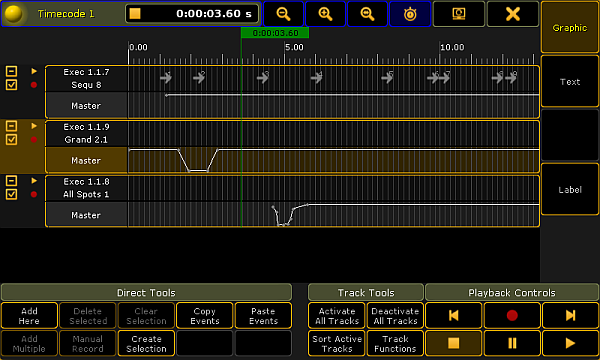
It has two modes that can be changed using the buttons on the right side. The only difference is in the Main part. Above is the Graphic style. Below is the Text style:
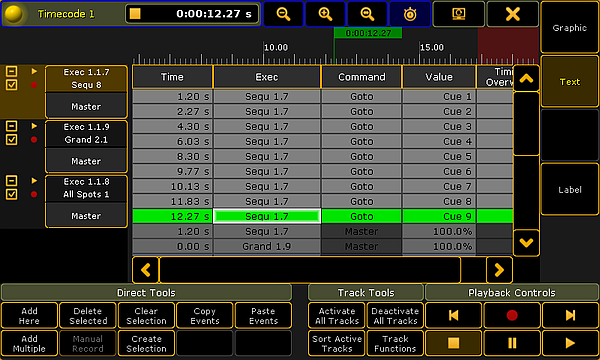
Title Bar
The left side of the title bar has the standard yellow ball that will open the Options when it is tapped. Continuing from left to right in the title bar, the next ting is the name and number of the timecode show. There is a area that displays the playback status (Stop, Play, Pause, and Record icons) and the current time. If there is a "+" in front of the time then a time offset is added.
There are three buttons that zoom the timeline in the graphic viewer. The first two zoom buttons (from left) is normal zoom in and out. The next button will zoom to view the entire recorded timecode show.
The next "zoom" button is actually a toggle button - this is called Follow Time. When it is active, the display always shows the active cue or time. Like Auto Scroll in a sheet. It moves the the green time marker and line from the left side and into the center of the screen when the show is recording or playing.
The last two buttons in the title bar are the standard buttons for moving the editor to a different screen, and the big X that closes the editor.
Remember that if the editor is on screen 1 then the right side buttons and possibly the bottom buttons can be operated by the U-keys and the X-keys. It is always possible to tap the buttons on the screens.
Right side buttons
As mentioned briefly above, there are two buttons on the right side of the editor that changes the mode of the main part between a Graphic and Text mode.
The Label button opens an Enter Name pop-up that will label the timecode show.
Bottom buttons
At the bottom there are a lot of buttons that allows for editing and controlling the timecode show. They are divided into three sections: Direct Tools, Track Tools, and Playback Controls.
Direct Tools:
Tapping these buttons will add, copy/paste, select and delete events.
- Add Here:
Adds an event at the current frame. If there is already an event at this time frame, it will add the event at the next frame. It will not create an event, if there is also something at the next frame. It will automatically add a Goto next cue or insert a marker on the current fader position. - Add Multiple:
This opens the Create Multiple Events pop-up.
Create Multiple Events pop-up
Here you can add more than one event at the same time. Set the Number of Events needed. Set an Interval or an Overall Timespan - they are linked based on the number of events. Finally set first cue for the events. The following cues will be added based on the number of events. If there are not enough cues, then the sequence in wrapped and the cues from the top are used. - Delete Selected:
Deletes all selected events. - Manual Record:
This function is currently not implemented. - Clear Selection:
Pressing this will deselect all selected events. - Create Selection:
This will open the Create Selection pop-up.
Create Selection pop-up
Here you can select multiple events. The left drop down list allows to select if the selection will be made On Current Subtrack, On Selected Tracks, or On All Tracks. The next three buttons allows to select all events Before (and including) the time marker, select All events, or all events After (and including) the time marker. - Copy Events:
Tapping this button will copy the currently selected events. It will copy all events in the selected track if there are no selected events. It is possible to select events from several tracks. - Paste Events:
This button inserts the copied events at the current time marker. If entire tracks have been copied, then it will offset the events and paste them with the 0 frame at the current time marker position. If several tracks are copied, it will paste into the respective new tracks.
Track Tools:
These are buttons that control how tracks are played back and it can be used to manually add or delete tracks.
- Activate All Tracks:
This will display all tracks in the Text mode of the editor. - Sort Tracks:
This will allow you to sort tracks in numerical order. Non-active tracks will be moved to the bottom of the list. - Deactivate All Tracks:
This will hide all tracks in the Text mode of the editor (recorded events will be executed). - Track Functions:
Gives you the Track Functions pop-up. There are a lot of track functions. This pop-up opens other pop-ups and can do more complex operations. Please read more about the track functions below.
Playback Controls:
These buttons control the playback and record state of the timecode show.
- Rewind (to the beginning):
Rewinds to the 0 (zero) time. - Stop:
Stop the running/playback or recording of the show. - Record:
Records the show from the current time. If the show is rewound and recorded again then it is possible to record more actions into the show. It will not delete what previously recorded. - Pause:
Temporary stops the running time or recording at the current time. - Forward (to the end):
Moves the time marker to the end of the show. - Play:
Plays the timecode show. Read more in the Playing Back a Timecode Show topic.
Track Functions
The Track Functions are opened by tapping the Track Functions button. It could look like this:
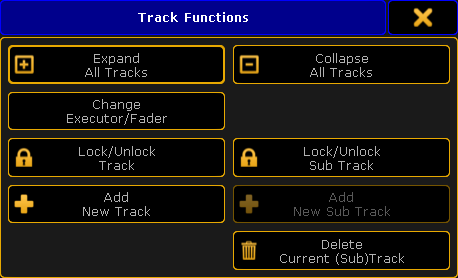
There are eight different buttons here:
- Expand All Tracks:
This will expand all the sub tracks in the timecode show. - Collapse All Tracks:
This will collapse (hide) all the sub tracks in the timecode show. - Change Executor/Fader:
Pressing this will open a Select executor for existing track pop-up. It could look like this: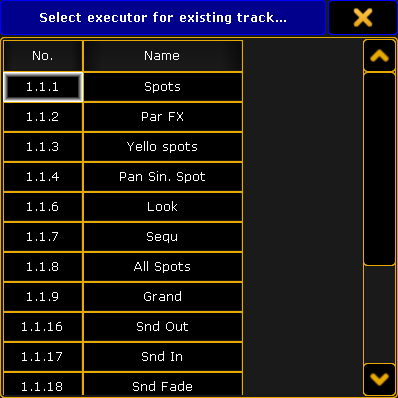
Select Executor for Existing Track pop-up
Here one of the existing executors can be selected for the currently selected timecode track. - Lock/Unlock Track:
Pressing this will lock or unlock the main AND sub tracks. Locked tracks get a yellow padlock icon. - Lock/Unlock Sub Track:
Pressing this will lock or unlock only the selected track or sub track. Be aware that a sub track can be locked by both lock buttons. Locked subtracks gets a yellow padlock icon. - Add New Track:
Pressing this will open a Select executor for new track pop-up. It looks exactly the same as the Select executor for existing track pop-up shown above.
Here a track can be selected from the list of executors. The selected executor will be added as a new track to the timecode show. - Add New Sub Track:
Pressing this will open a Select New Sub Track pop-up.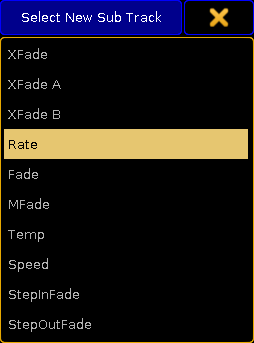
Select New Sub Track pop-up
Here a fader function can be selected to be added as a new sub track to the timecode show. - Delete Current (Sub) Track:
Pressing this will delete the track. If the current track is the main track then it will also delete the sub tracks.
Main part
The main part of the Timecode Editor has a time line at the top. With a green marker displaying the current position. This marker cannot have a minus value - since timecode cannot be a negative value.
On the left side there is a small area displaying the different tracks. There are at least one track that have all the executor actions (key presses and releases). The main track is represented by an area with a dark background. There is the executor number on the top line and the sequence number and name on the next line. Below this there might be subtracks. Subtracks contain fader movement. The executor can be changed using the Track Functions or by pressing the Edit key and then press one of the tracks (or right-click them with the mouse), this will open pop-ups that can be used to select a new executor or subtrack type.
On the far left side next to each main track there are four different symbols. One of them is a small square with a plus or minus. This will expand or collapse the subtracks of the current track. There is also a small square with either a small check mark or it is empty. This will display or hide the track in the Text mode of the editor. Then there is the small "play" icon. If this has a disabled symbol across it, then this track and subtracks will not be executed when the show is played back. The last icon is a "record" icon. If this has en disabled symbol across it, then this track and subtracks will not be changed during a recording. These icons are changed by tapping them.
The rest of the main part is different depending on what mode is selected.
Graphic Mode
In the Graphic mode there are tracks expanding from the areas with the executor numbers and (if expanded) the faders. The events are displayed with different symbols.

The picture above shows the expanded track. The top row displays some of the different events. The subtrack rows displays the fader movement. All the events can be edited by right clicking them with a mouse.
The green vertical line is the current time. There is one time marker for each timecode show in a network session. If Follow Time is activated (in the title bar) then the last played action in the main track is automatically selected during playback. If the timecode source is the internal source, then the time will be paused if the 4th (right most) encoder is turned and this also moves the position of the last event.
The symbols in the top row differs with the different actions. The number next to some of the symbols is the cue number. There might also be a text, this is the cue name.
Right clicking one of the events opens the Event Command pop-up.
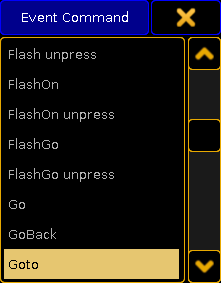
Here it is possible to select a different action for the event.
Event when the Go key was pressed during the recording then the stored action is actually a Goto action. This is to make sure that the recorded cue is the one being played back.
Text Mode
The text mode changes the main part to something like this:
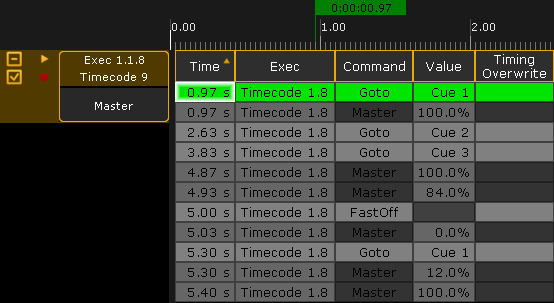
This is the events represented in a spread sheet style. There are 5 columns:
- Time:
This is the time for the action or command. - Exec:
This is the name of the sequence and the number of the executor. - Command:
This is the command or action that is performed. - Value:
The value is the cue number or the fader position connected to the command/action. - Timing Overwrite:
A value here will open the Calculator pop-up. It can be used to write a new value that will be used as Fade time for cues actions instead of the otherwise stored time.
It overwrites the stored cue timing. All delays are set to 0 (zero) and individual times are ignored. It affects all cue parts.
Each row is an event in the timecode show. The rows with the light gray background are the events in the selected track. The row with the green background are the selected event. Rows with a darker gray color is events in a not selected track.
The last executed event is automatically selected when the show is running. If the time source is the internal clock and the 4th encoder is turned during playback then the time will automatically pause and the selected event is moved.
Everything that does not have a very dark gray background can be edited. Editing a cell will open a pop-up that can edit the values. For instance editing a value cell that is a cue, will open the Select Cue pop-up. It could look like this:
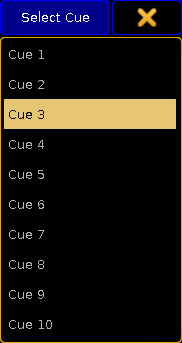
Here a different cue can be selected.
The columns can be sorted by tapping the column title and swiping up or down. This will sort the column ascending or descending and is also symbolized with a small arrow pointing up or down.
Timecode Show Options
Tapping the yellow ball in the upper left corner of the Timecode Editor opens the options. The options could look like this:
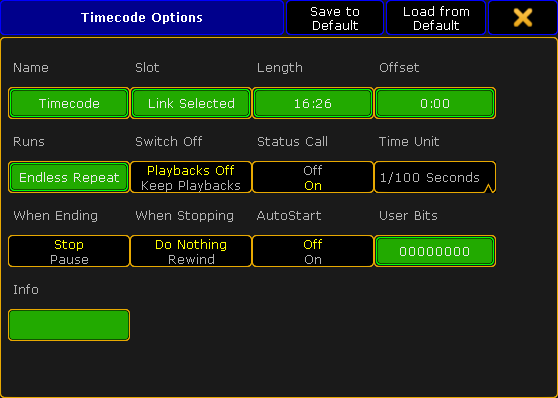
This is a short description of the different options:
- Name:
Here the name of the timecode show can be edited. - Slot:
Tapping this field will open the Select Timecode Slot pop-up. Here it can be selected if the time source is internal, linked to the selected slot or fixed to one of the 8 slots. The pop-up looks like this:
Select Timecode Slot pop-up
- Length:
The total length of the show. - Offset:
Allows to set a (positive) time offset for the entire timecode show. For instance adding an hour to the entire show without having to move all the events. - Runs:
This is used if the time source is internal. Then the timecode show can be set to loop a number of times or do an endless loop (until stopped manually). - Switch Off:
This has two options: Playback Off or Keep Playbacks. This defines what happens with playbacks (started by the timecode show) when the timecode show is turned off. - Status Call:
When Status Call is turned on, then the timecode show will sync with the timecode signal instantly. When it is off it will execute the action when the event is reached. Example: The timecode show is turned on when the time is between a "Goto Cue 1" and a "Goto Cue 2". With Status call On, a Goto Cue 1 is immediately executed - it is the status the timecode show is suppose to have. When it is Off, it will not run cue 1 but wait till it reaches the "Goto Cue 2" event. - Time unit:
Pressing here opens the Select Time Unit pop-up. It looks like this: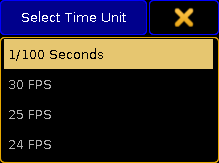
Select Time Unit pop-up
Here the displayed time unit can be selected. The options are: 1/100 Seconds, 30 FPS, 25 FPS, or 24 FPS. This is not depended on the incoming time signal. This is only for the graphic display mode. (FPS = frames per second). - When Ending:
This has two different options: Stop or Pause. This decides what happens when the timecode show runs out of recorded time. This option does not have any effect when using an external time source! - When Stopping:
This has two different options: Do Nothing or Rewind. This decides what should happen when the timecode show is stopped. - Autostart:
This has an On or Off option. Should the timecode show begin automatically when the time source is running. This option is not available when using an internal time source. - User Bits:
Beside the 32 Bit for 8 digit timecode time, timecode executes 32 User bits (8 digit) per frame. User bits can transmit several kinds of information, for example a second timecode stream. So several incoming timecode streams can be discerned. This is not available when using an intern timecode source. Do not change this unless told by the ones supplying the time source. - Info:
Here it is possible to add some info text to timecode show.
The options can be closed by tapping the yellow "X" in the upper right corner.


